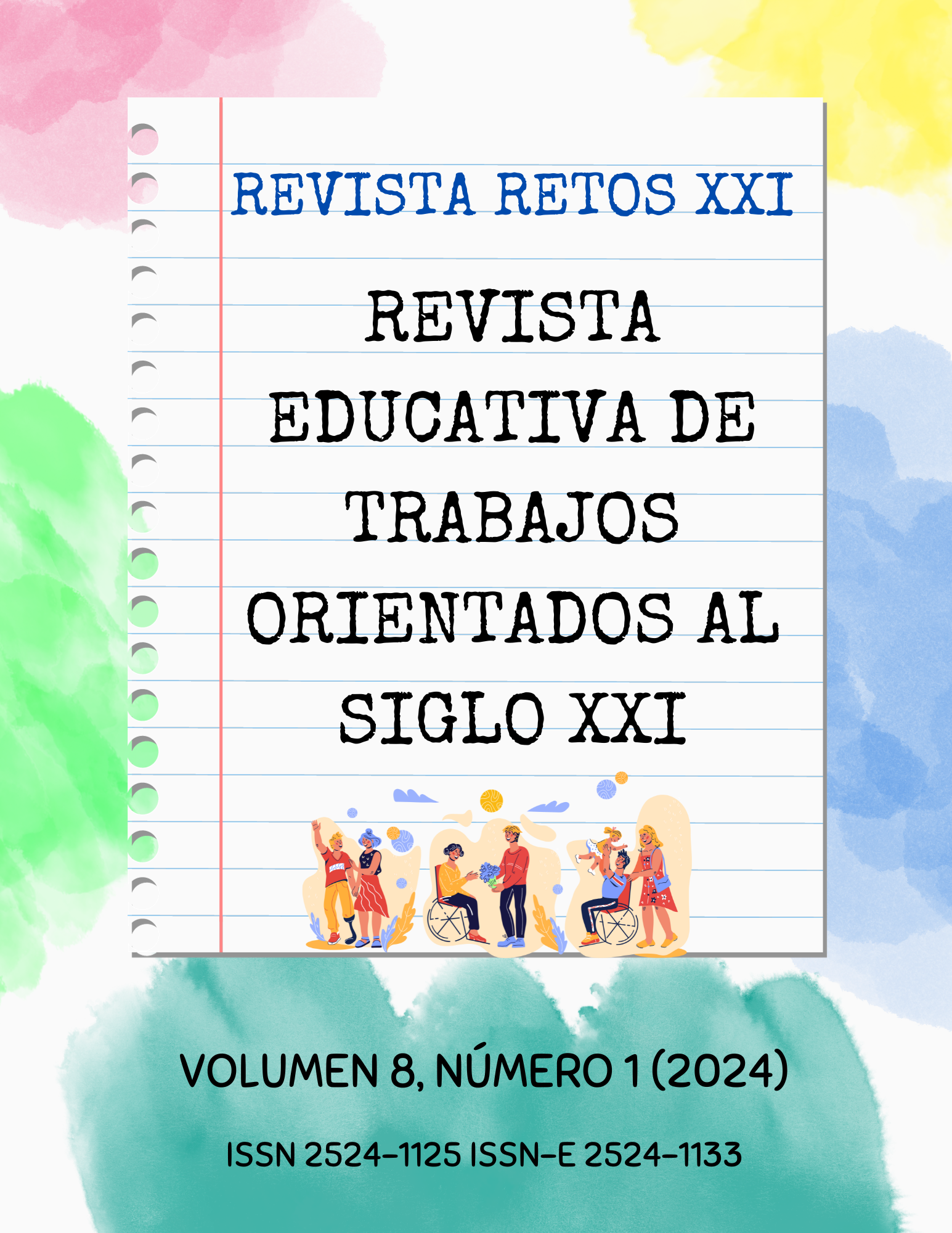Español
DOI:
https://doi.org/10.30827/retosxxi.8.2024.29066Keywords:
Multimedia, Teorías del aprendizaje multimedia, Aprendizaje social y emocional, Factores no cognitivos, Habilidades digitales., multimedia learning theories, social and emotional learning, non-cognitive factors, digital skillsAbstract
The aim of the document is to explain the theories on which the use of digital technologies in the learning process is based, considering the humanistic aspect of the students. To understand in students the influence of the multimedia contents of the didactic resources that use digital technologies as a didactic strategy, for the teaching-learning process, computer applications created by the authors are mentioned, that influence the attitudinal aspect (behavioral, cognitive and the emotional) in the students. Heuristic methods were used based on the results obtained, such as the facts presented in this document when describing the findings found using multimedia teaching resources. The
Downloads
References
Andrade-Lotero, L. A., (2012). Teoría de la carga cognitiva, diseño multimedia y aprendizaje: un estado del arte. Magis. Revista Internacional de Investigación en Educación, 5(10), 75-92.
Baddeley, A. (2003). Working memory and language: an overview. Journal of communication disorders, 36(2003), 189-208. doi:10.1016/S0021-9924(03)00019-4
Contreras, M. M., Páramo, D., y Rojano, Y. N. (2019). La teoría fundamentada como metodología de construcción teórica. Pensamiento & Gestión, (47), 283-306.
Gallardo, C.P., Rodríguez, A., Caurcel, M.J. y (2021a). Apps for people with autism: Assessment, classification and ranking of the best. Technology in Society, 64 (101474), 1-10. https://doi.org/10.1016/j.techsoc.2020.101474
Gallardo-Montes, C.d.P., Caurcel Cara, M.J. & Rodríguez Fuentes, A. (2021b). Technologies in the education of children and teenagers with autism: evaluation and classification of apps by work areas. Education and Information Technologies, 27, 4087–4115. https://doi.org/10.1007/s10639-021-10773-z
González-Sanmamed, M., Estévez, I., Souto-Seijo, A., y Muñoz-Carril, P. C. (2020). Ecologías digitales de aprendizaje y desarrollo profesional del docente universitario. Revista Comunicar, 28(62), 9-12.
Guàrdia, L., & Sangrà, A. (2005). Diseño instruccional y objetos de aprendizaje; hacia un modelo para el diseño de actividades de evaluación del aprendizaje online. RED. Revista de Educación a Distancia, (IV), 1-14.
Guàrdia, L. (2012). El diseño formativo: un nuevo enfoque de diseño pedagógico de los materiales didácticos en soporte digital. En A. Sangrà y J. M. Duart (comp.), Aprender en la virtualidad (171-187). EDIUOC/Gedisa.
Hessen, J. (2007). Teoría del conocimiento. Grupo Editorial Tomo.
Jiang, M. L y Tse, W. C. (2022). The Effects of Multimedia Glosses, Learning Duration and Working Memory Capacity on High School Students' Passive English Vocabulary Acquisition. Association for Computing Machinery.
Latapie, I. (2007). Acercamiento al aprendizaje multimedia. Investigación Universitaria Multidisciplinaria, 6, 7-14. http://biblioteca.udgvirtual.udg.mx/jspui/handle/123456789/1032
Linares, M., Aleas, M., Mena, J. A., Cruz, D., & Rosales, D. (2022). Estrategia didáctica para el proceso de enseñanza-aprendizaje del diseño de software con la utilización del método de proyecto. Revista Cubana de Información en Ciencias de la Salud, 33, e1687. http://scielo.sld.cu/scielo.php?script=sci_arttext&pid=S2307-
Mayer, R. E. (2010). Multimedia Learning. Cambridge University Press.
Mohsen, M. A., y Balakumar, M. (2011). A review of multimedia glosses and their effects on L2 vocabulary acquisition in CALL literature. ReCALL, 23(2), 135-159. 10.1017/S095834401100005X.
Paivio, A. (2006). Dual coding theory and education. “Pathways to Literacy Achievement for High
Poverty Children”. The University of Michigan School of Education.
Polo, M. y Cedeño, K. (eds.) (2016). Estrategias didácticas y herramientas multimedia para apoyar el proceso de aprendizaje de la lógica de programación (tesis de Grado). Universidad Central de Venezuela.
Reigeluth, C. M. (Ed.). (2012). Instructional-design theories and models: A new paradigm of instructional theory. RED Revista de Educación a Distancia, 32, 1-22.
Richey, R. C., Fields, D. C. y Foxon, M. (2001). Instructional design competencies: The standards (3.ª ed.). ERIC Clearinghouse.
Rodríguez, A. Alain, L. y García. F. (2020). Ensenias: herramienta tecnológica para aprender, enseñar, mejorar y usar la Lengua de Signos Panameña. Íkala, 25(3), 663-678. http://10.17533/udea.ikala.v25n03a05
Rodríguez, A., Alaín, L. y García, F. (2022). Presentation and evaluation of a digital tool for sign language. Culture & Education, 34(2). https://doi.org/10.1080/11356405.2022.2058793
Sarmiento, M. (2004). La enseñanza de las matemáticas y las Ntic. Una estrategia de formación permanente, Universitat Rovira I Virgili, ISBN: 9788469082942, Recuperado de: http://hdl.handle.net/10803/8927
Secretaría de Educación Pública Gobierno de México. (2023). Educación Especial. Línea Técnica Operativa de los Servicios de Educación Especial Valle de México. https://educacionespecial.sep.gob.mx/storage/recursos/2023/05/R19CkfZGyF-EdoMEx_valle_LINEAMIENTO-CAM-2017.pdf
Sharif, A., & Cho, S. (2015). Diseñadores instruccionales del siglo XXI: cruzando las brechas perceptuales entre la identidad, práctica, impacto y desarrollo profesional. RUSC. Universities and Knowledge Society Journal, 12(3), 72-86.
Sweller, J., & Chandler, P. (1991). Evidence for cognitive load theory. Cognition and instruction, 8(4), 351-362.
Wiedbusch, M. D. and Azevedo, R. (2020). Modeling Metacomprehension Monitoring Accuracy with Eye Gaze on Informational Content in a Multimedia Learning Environment. Association for Computing Machinery.
Wittrock, M. C. (1992). Generative learning processes of the brain. Educational Psychologist, 27(4), 531-541.
Zuppardo, L., Serrano, F., & Pirrone, C. (2017). Delimitando el perfil emotivo-conductual en niños y adolescentes con dislexia. RETOS XXI, 1(1), 88–104. https://revistaseug.ugr.es/index.php/RETOSXXI/article/view/24027
Zuppardo, L., Rodríguez, A., y Serrano, F. (2019). Sotfware Lectoescritores contra la Dislexia y Disortografía. EduTicInnova, 7, 27-39. https://www.aulavirtualusmp.pe/ojs/index.php/eduticinnova/article/view/1845
Published
How to Cite
Issue
Section
License
Copyright (c) 2024 The Educational Journal of Works Aimed at the XXI century (XXI CHALLENGES)

This work is licensed under a Creative Commons Attribution-NonCommercial-ShareAlike 4.0 International License.












